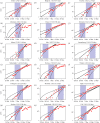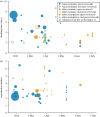Challenges in control of COVID-19: short doubling time and long delay to effect of interventions
- PMID: 34053267
- PMCID: PMC8165602
- DOI: 10.1098/rstb.2020.0264
Challenges in control of COVID-19: short doubling time and long delay to effect of interventions
Abstract
Early assessments of the growth rate of COVID-19 were subject to significant uncertainty, as expected with limited data and difficulties in case ascertainment, but as cases were recorded in multiple countries, more robust inferences could be made. Using multiple countries, data streams and methods, we estimated that, when unconstrained, European COVID-19 confirmed cases doubled on average every 3 days (range 2.2-4.3 days) and Italian hospital and intensive care unit admissions every 2-3 days; values that are significantly lower than the 5-7 days dominating the early published literature. Furthermore, we showed that the impact of physical distancing interventions was typically not seen until at least 9 days after implementation, during which time confirmed cases could grow eightfold. We argue that such temporal patterns are more critical than precise estimates of the time-insensitive basic reproduction number R0 for initiating interventions, and that the combination of fast growth and long detection delays explains the struggle in countries' outbreak response better than large values of R0 alone. One year on from first reporting these results, reproduction numbers continue to dominate the media and public discourse, but robust estimates of unconstrained growth remain essential for planning worst-case scenarios, and detection delays are still key in informing the relaxation and re-implementation of interventions. This article is part of the theme issue 'Modelling that shaped the early COVID-19 pandemic response in the UK'.
Keywords: early growth rate; incubation period; non-pharmaceutical interventions; onset-to-hospitalization delay; reproduction number; unconstrained epidemic.
Figures




References
-
- World Health Organization (WHO). 2020. WHO Director-General's opening remarks at the media briefing on COVID-19 – 11 March 2020. See https://www.who.int/dg/speeches/detail/who-director-general-s-opening-re... (accessed on 29 March 2020).
-
- World Health Organisation (WHO). 2020. Coronavirus disease (COVID-2019) situation report 69, 29 March 2020. See https://www.who.int/docs/default-source/coronaviruse/situation-reports/2... (accessed on 29 March 2020).
-
- World Health Organization (WHO) and the Chinese Centre for Disease Control and Prevention. 2020 Report of the WHO-China joint mission on Coronavirus disease 2019 (COVID-19). See https://www.who.int/docs/default-source/coronaviruse/who-china-joint-mis... (accessed on 29 March 2020).
-
- Istituto Superiore di Sanità. 2020. Daily reports, (29.03.2020). See http://www.salute.gov.it/portale/news/p3_2_1.jsp?lingua=italiano&menu=no....
Publication types
MeSH terms
Grants and funding
LinkOut - more resources
Full Text Sources
Other Literature Sources
Medical

